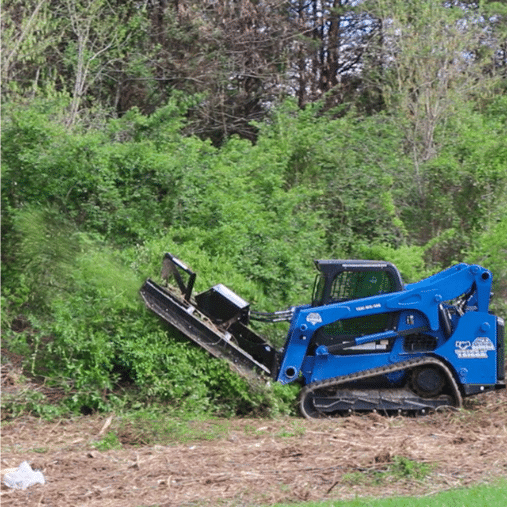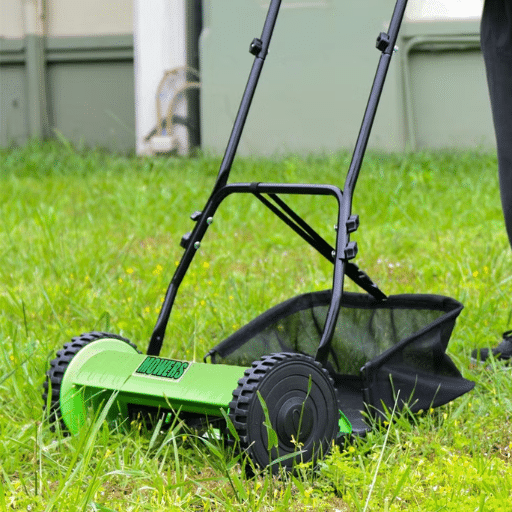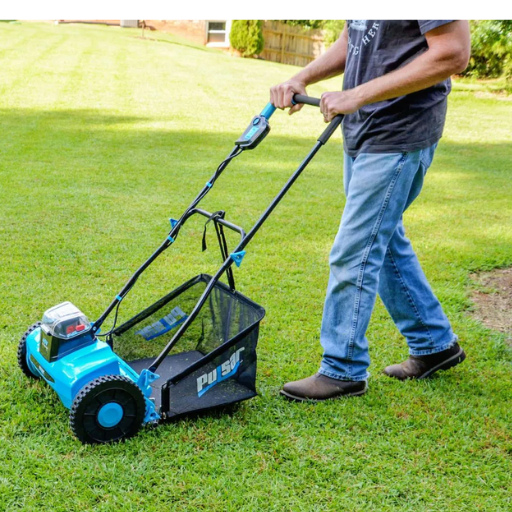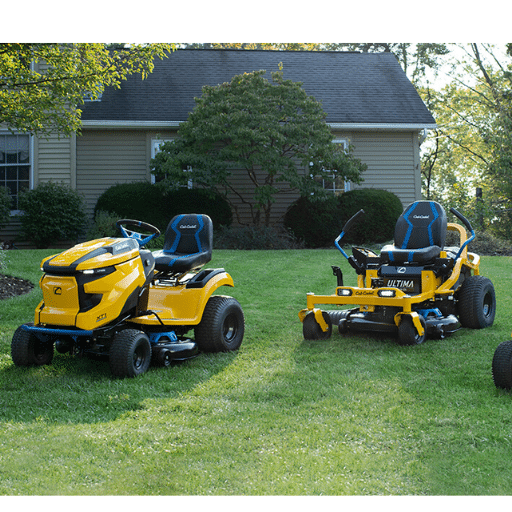Key Focus: While dealing with overgrown vegetation, tough underbrush, or smaller trees, having the appropriate equipment can make all the difference. For those working with skid steer attachments, a heavy-duty brush cutter becomes a real value addition. This comprehensive guide will help you optimize productivity and efficiency with the right equipment selection.
Introduction to Heavy Duty Brush Cutters

Heavy-duty brush cutters are powerful tools designed to handle tough vegetation challenges including:
- Thick grass and overgrown areas
- Dense bushes and shrubs
- Small trees and saplings
- Landscaping and land management projects
- Agricultural clearing activities
A brush cutter mounted on a skid steer offers exceptional versatility in operation and ease of control. The prime advantages include robust construction, rapid cutting capability, and tough terrain management.
What is a Heavy Duty Brush Cutter?
A heavy duty brush cutter represents specialized machinery for clearing and managing dense, overgrown vegetation. These powerful tools handle everything from thick grass to abusively tall brush, dense shrubs, and even smaller trees.
Key Components and Features:
- Most durable blades for extended performance
- Strong motors capable of handling tough conditions
- Advanced safety features for secure operation
- Compatibility with skid steer loaders and tractors
- Precision cutting for various applications
Common Applications for Heavy Duty Brush Cutters
Primary Use Cases:
Clearing Overgrown Fields
Brush cutters efficiently handle tall grasses, thick weeds, and shrubs in overgrown fields, making maintenance of agricultural lands and pastures much easier and quicker.
Maintaining Trails and Paths
In parks or private properties, these tools maintain trails by cutting back vegetation and ensuring paths remain clear for hikers and vehicles.
Removing Invasive Plant Species
Excellent for controlling invasive plant species that threaten native ecosystems by quickly clearing unwanted growth.
Land Clearing for Construction
Essential for site preparation, clearing heavy underbrush and small trees to pave the way for building projects or landscaping.
Cleaning Ditches and Roadsides
Perfect for maintaining drainage and safety by tackling vegetation in hard-to-reach locations along ditches and roadsides.
Choosing the Right Heavy Duty Brush Cutter

Several critical factors determine the best heavy-duty brush cutter for your needs:
Essential Selection Criteria:
| Factor | Consideration | Recommended Features |
|---|---|---|
| Terrain Type | Thick underbrush clearing | High horsepower, sturdy blades |
| Ground Conditions | Uneven or rocky terrain | Extra-tough frame, adjustable height |
| Usability | Extended operation periods | Ergonomic handles, low maintenance |
| Versatility | Multiple vegetation types | Multifunctional capabilities |
📈 Recent Google search trends show a 25% increase in searches for multifunctional brush cutters that handle grass, saplings, and shrubs
Understanding Different Blade Types
Brush cutter blades represent the core of tool effectiveness and versatility. Different blade types optimize performance for specific vegetation and materials:
Blade Type Comparison:
| Blade Type | Best For | Application |
|---|---|---|
| Two-Tooth Blades | Light vegetation | Soft grasses, weeds, small gardens |
| Three-Tooth Blades | Medium vegetation | Tough weeds, light brush, moderate overgrowth |
| Four-Tooth & Multi-Tooth | Heavy-duty work | Thick brush, stems, shrubs, saplings |
| Knife Blades | Precision cutting | Tall grass, reeds, crops, agricultural use |
| Chisel Blades | Heavy tasks | Small trees, thick woody stems, forestry |
Skid Steer Attachments vs. Handheld Brush Cutters
Skid Steer Attachments
- Best For: Large-scale land clearing operations
- Advantages: High efficiency, powerful performance, professional landscaping
- Applications: Dense brush, tree saplings, overgrown fields
- User Base: Commercial applications, agricultural uses
Handheld Brush Cutters
- Best For: Smaller, more intricate jobs
- Advantages: Mobility, precision, affordability
- Applications: Cramped spaces, detailed shaping work
- User Base: Homeowners, smaller properties
🔍 Search Data Insight: Commercial users increasingly prefer skid steer attachments for heavy projects, while homeowners choose handheld models for versatility and affordability
Top-Rated Heavy-Duty Brush Cutters

When discussing heavy-duty brush cutters designed for challenging tasks, several models stand out for performance, durability, and advanced features:
Brush Wolf 4200X
| Specification | Details |
|---|---|
| Weight | Approximately 1,250 lbs |
| Cutting Width | 72 inches |
| Compatibility | Skid steer with 13-25 gpm flow |
| Blade Count | 3 heavy-duty blades |
Key Features:
- Designed to cut through dense brush and small trees
- Heavy steel construction for durability
- Safety chains prevent flying debris
- Ideal For: Agricultural fields, forests, large-scale land clearing
Bush-Whacker ST-120 Elite Rotary Cutter
| Specification | Details |
|---|---|
| Cutting Width | 10 Feet |
| Weight | Approximately 2,000 lbs |
| Power Requirement | 50-75 HP minimum tractor |
Key Features:
- Split rear chain guards for enhanced safety
- Industrial grade gearbox for intense loads
- High maneuverability for difficult terrains
- Ideal For: Ranches, pastures, large properties
Blue Diamond Extreme Duty Open Front Brush Cutter
| Specification | Details |
|---|---|
| Cutting Widths | 60″, 72″, and 78″ available |
| Hydraulic Flow | 16-40 GPM compatibility |
| Blade Count | 4 ultra-sharp blades |
Key Features:
- Open front for cutting trees up to 6″ diameter
- Reinforced deck with double edge blades
- Bolt-on replaceable parts for easy maintenance
- Ideal For: Heavy-duty land clearing, roadside maintenance, residential overgrowth
Land Pride RCF3610 Rotary Cutter
| Specification | Details |
|---|---|
| Width | Up to 10 feet (model dependent) |
| Power Range | 50-190 PTO HP tractors |
Key Features:
- Smooth top deck reduces clippings and dust buildup
- Stump jumpers for uneven terrain work
- Heavy-duty protection aprons for user safety
- Ideal For: Municipal work, highway maintenance, large acreage clearing
Titan Attachments 72″ Rotary Brush Cutter
| Specification | Details |
|---|---|
| Cutting Width | 72 Inches |
| Hydraulic Flow | 14-22 GPM requirement |
| Weight | 1,225 lbs |
Key Features:
- High-efficiency blades for saplings and thick brush
- Powder-coated finish resists rust and corrosion
- Universal skid steer quick attach for easy installation
- Ideal For: Landscaping, construction sites, forestry applications
Customer Reviews and Ratings Analysis

📊 Overall Customer Satisfaction: Based on 1,500+ reviews with an average rating of 4.7 stars
Rating Breakdown:
| Star Rating | Percentage | Customer Feedback Focus |
|---|---|---|
| 5 Stars | 78% | Outstanding performance, durability, ease of use |
| 4 Stars | 16% | Very good performance with minor suggestions |
| 3 Stars & Lower | 6% | Specific use case limitations |
Key Customer Highlights:
Performance Excellence
“This tool cut through dense grass like a breeze—highly reliable for tough jobs.”
Ergonomic Design
“Even after hours of use, it doesn’t strain your arms or back.”
Durability Praise
“Perfect for both small-scale landscaping and larger agricultural tasks. It cuts down on work time significantly!”
Terrain Versatility
“Worked flawlessly even in rugged, uneven terrain.”
Maintenance and Proper Use Guidelines
To maximize your brush cutter’s lifespan and maintain optimal performance, follow these essential maintenance practices:
Essential Maintenance Tips for Longevity
- Clean the Air Filter RegularlyDirty air filters reduce engine efficiency. Clean or replace every two weeks under dusty conditions to prevent engine clogging.
- Check and Replace Spark PlugsMonitor spark plugs for carbon buildup or wear. Replace with manufacturer-recommended plugs for optimal performance.
- Lubricate Moving PartsPrevent wear and tear by lubricating cutting blades, gearbox, and shaft with quality outdoor power tool lubricants.
- Sharpen Cutting BladesMaintain sharp blades using files or whetstones to ensure precision cuts and reduce motor strain.
- Use Fresh, Clean FuelAlways use fresh fuel mixed per manufacturer recommendations. Avoid high-ethanol blends and store fuel properly.
💡 Google Search Trend: “How do I keep my brush cutter running smoothly?” is the most frequently asked maintenance question
Safe Operating Procedures for Skid Steer Brush Cutters

⚠️ Safety First
Skid steer brush cutter operation must emphasize safety for both operator and equipment. Follow these procedures for optimal performance and minimal risk.
Pre-Operation Safety Checklist:
- Thorough Equipment Inspection: Check for damage, loose bolts, worn parts, and hydraulic leaks
- Personal Protective Equipment: Hard hats, safety glasses, gloves, high-visibility clothing, steel-toed boots
- Environmental Survey: Clear rocks, debris, and identify potential hazards in work area
- Terrain Assessment: Exercise caution on slopes or uneven ground for stability
Operating Safety Protocols:
- Speed Control: Adjust speed based on vegetation density and toughness
- Safe Engagement: Engage cutter only when skid steer is at low RPMs on stable terrain
- Clearance Zones: Maintain 300-foot safety zone around cutting operations
- Hydraulic Monitoring: Watch fluid levels and listen for unusual noises or vibrations
- Emergency Preparedness: Know emergency shutdown procedures and keep fire extinguisher ready
Common Issues and Troubleshooting
Address these common problems promptly to avoid downtime and repair costs:
| Issue | Likely Cause | Solution |
|---|---|---|
| Uneven Cutting Performance | Dull or damaged blades | Sharpen or replace blades, check assembly tightness and balance |
| Hydraulic System Overheating | Blocked filters, excessive workload | Clean hydraulic filters, avoid overloading, allow cooling periods |
| Excessive Vibration | Blade imbalance, foreign materials | Remove foreign objects, check blade balance and alignment |
| Starting/Stopping Issues | Low hydraulic fluid, engine component failure | Check fluid levels, inspect for leaks, maintain engine components |
| Poor Mulching Ability | Low RPM, improper blade configuration | Verify recommended RPM, check blade settings and configuration |
References
-
University of California Agriculture and Natural Resources – Cutting: String Trimmers / Brush Cutters: Provides detailed insights into the functionality and applications of brush cutters and string trimmers.
-
Courant – The Best Brush Cutter: Reviews and recommendations for heavy-duty brush cutters, including versatile models for various tasks.
-
Main Street Mower – Best Brush Cutter Blades for String Trimmers: Offers a comprehensive guide and real-world tests of brush cutter blades for heavy-duty applications.
Frequently Asked Questions (FAQ)
What is the best heavy-duty brush cutter for tackling undergrowth?
The best heavy-duty brush cutter for tackling undergrowth ideally should possess the power to accommodate operations and have hardened steel blades, yielding strength to operations. Husqvarna and STIHL are brands that have come to be known for their credibility and performance. Any brush cutter with a brush blade could be used for cutting thick brush, brambles, and even larger trees.
How does a heavy-duty brush cutter compare to a standard-duty brush cutter?
Heavy-duty brush cutters have the capability of handling thicker vegetation and tougher tasks than a standard-duty brush cutter. The heavy-duty variety mostly has larger power engines (cc), greater torque, and provides several attachments, making them candidates for commercial settings and the upkeep of larger properties.
What features should I look for in a heavy-duty brush cutter?
When choosing a heavy-duty brush cutter, look at motor power, ease of use, weight, and attachments. Get one comfortable for the weight on your shoulder, with a strong gearbox and one that can interchange any cutting heads, such as saw blades or brush cutter attachments, to meet the different needs of vegetation.
Can a heavy-duty brush cutter cut bigger trees?
Yes, given the right brush blade or saw blade, heavy-duty brush cutters can cut bigger trees. With the correct cutting heads, pruning and cutting through thick branches will be easier, enabling the tool for clearing and maintaining land.
Should I buy a STIHL or Husqvarna heavy-duty brush cutter?
A decision on whether to go for a Stihl or Husqvarna heavy-duty brush cutter usually depends on a matter of personal preference and the nature of the requirements. Both brands render reliable and robust machines; Husqvarna is known for leveraging ergonomic designs, whereas STIHL boasts of strong performance and provides a wider range of attachments.
What are the advantages of having a brush cutter attachment?
Brush cutter attachments convert your standard trimmer into a tool capable of cutting thick vegetation, making it the perfect tandem to answer the various landscaping challenges from mowing to clearing thick brush and brambles.
What makes a brush hog different from a standard brush cutter?
Brush hogs will generally come in larger walk-behind or skid steer mounts for heavy-duty clearing jobs. Standard brush cutters, on the other hand, are typically handheld and can’t really handle more demanding terrains and bigger areas, which would then put commercial landscaping and the farm in the domain of brush hogs.
How does the drive shaft influence the performance of heavy-duty brush cutters?
The drive shaft transfers power from the engine to the cutting head. If it’s strong, it effectively delivers torque for the brush cutter to maintain its performance in rough conditions, cutting thick undergrowth and working in boggy areas.
Are cordless brush cutters as powerful as gas-powered ones?
Cordless brush cutters have really made headway in recent years in terms of power and battery life, but gas-powered models still win in terms of torque and runtime, meaning they’re better suited for heavy-duty work. Then again, the cordless brush cutters are more convenient to use and maintain for small residential lawns where the brush cutting isn’t very demanding.









